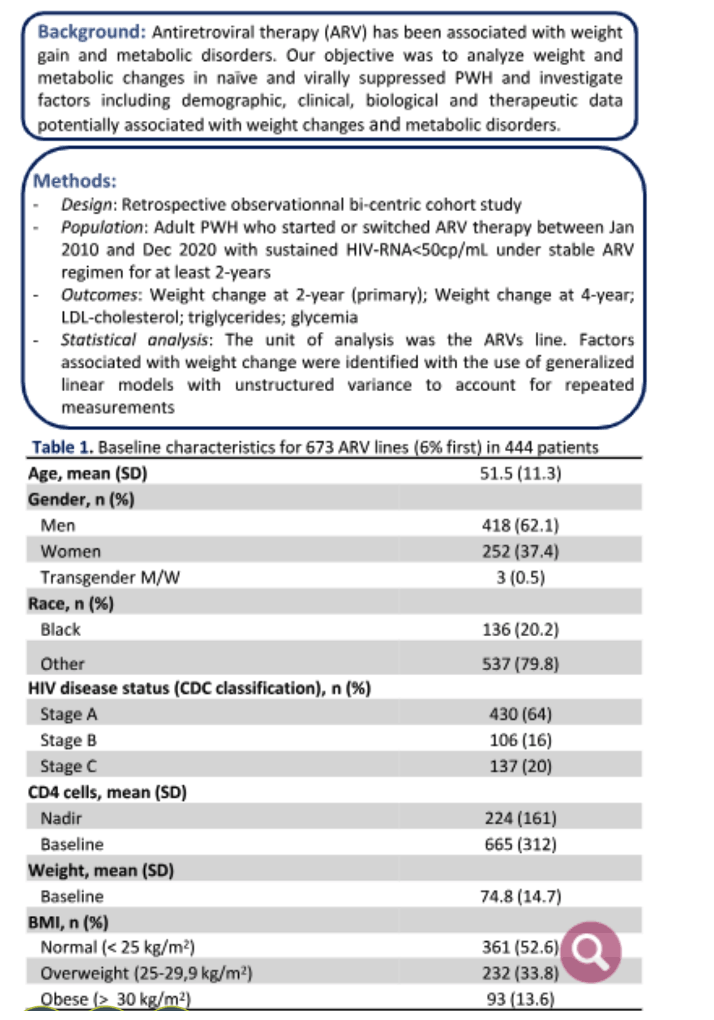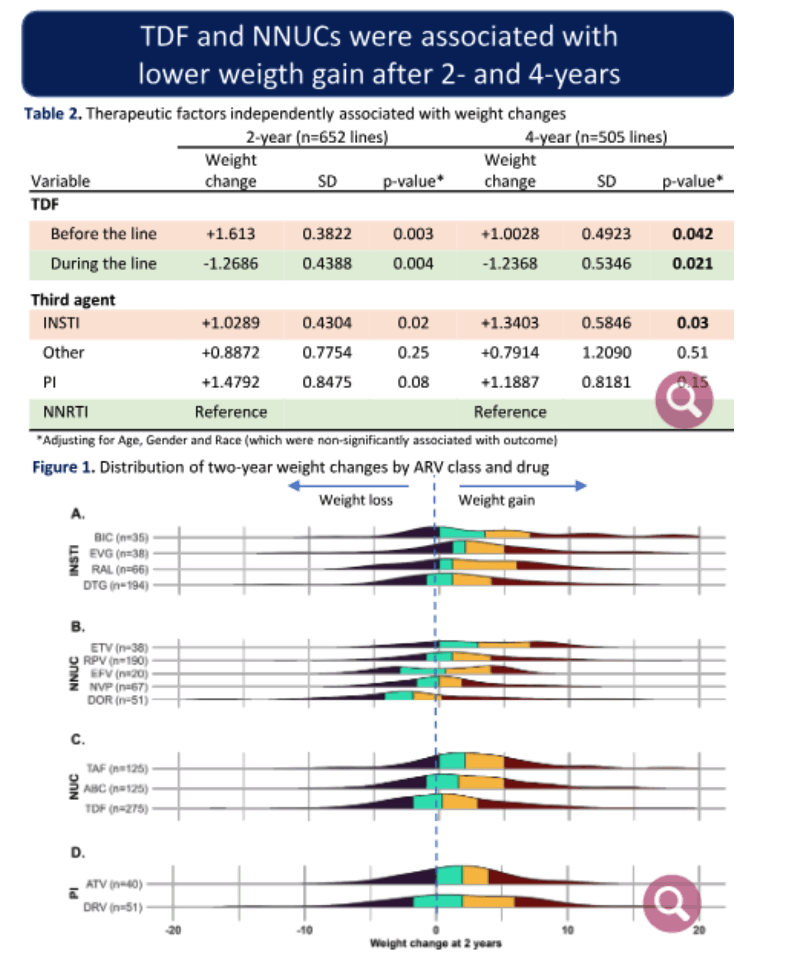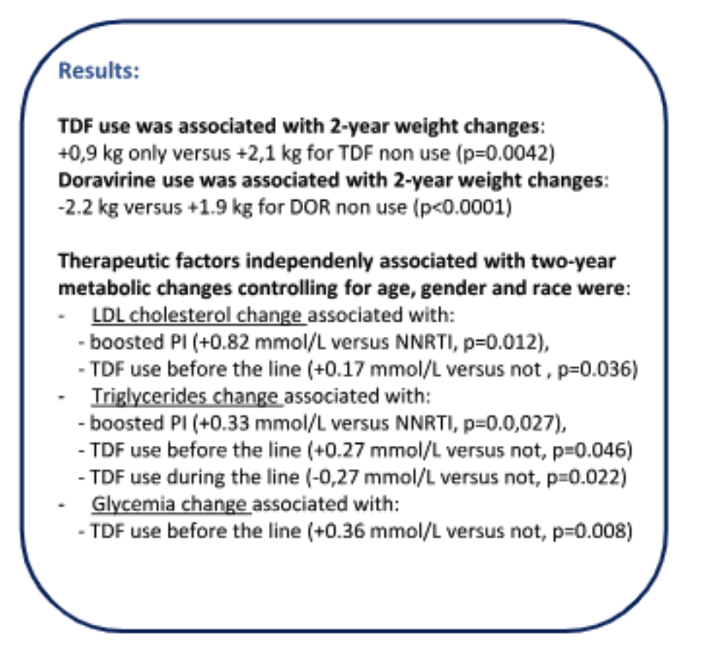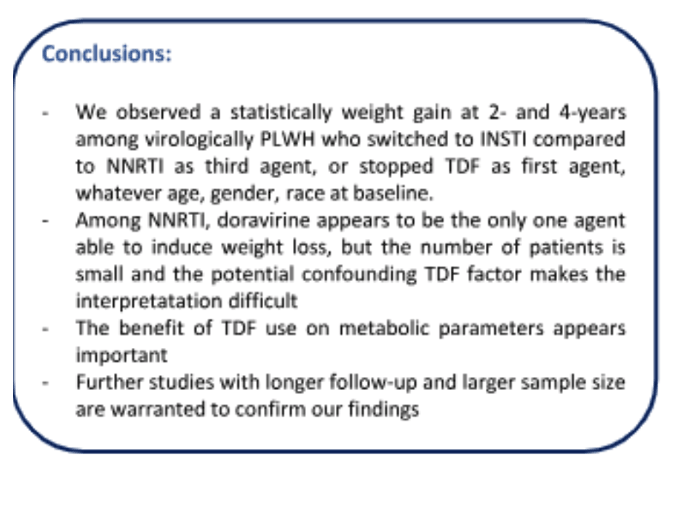 |
 |
 |
| |
Real-world 2-year weight changes among people with
sustained HIV suppression: a multicenter French retrospective cohort study
|
| |
| |
French Study Confirms Findings on Weight Gain with INSTIs, Loss With TDF
EACS 2023, October 18-21, 2023, Warsaw
Mark Mascolini
Two and four years after switching to an integrase inhibitor (INSTI), HIV-positive adults in France gained more weight than people who switched to a nonnucleoside [1]. And tenofovir disoproxil fumarate (TDF) could be tied to weight loss in this analysis of 444 people who switched their antiretroviral combination. The findings of this real-world study partly reflected those in a recent pooled analysis of 8 phase 3 trials [2].
The two-center retrospective French analysis included adults starting or switching antiretroviral therapy between January 2010 and December 2020 who kept their viral load below 50 copies for at least 2 years. They received care in the northern France cities of Caen and Amiens. Besides weight change after 2 and 4 years, the researchers also tracked changes in LDL cholesterol, triglycerides, and blood glucose.
The study focused on 444 people taking 673 different antiretroviral combinations. Their age averaged 51.5 years, 62.1% were men, 37.4% women, and 0.5% transgender. One in 5 cohort members was black. Initial weight averaged 74.8 kg, 52.6% had normal weight by body mass index, 33.8% were overweight, and 13.6% were obese.
An analysis adjusted for age, gender, and race linked TDF to a significant 2-year weight loss compared with non-TDF regimens (-1.2686 kg, P = 0.004), and that loss persisted through 4 years (-1.2368, P = 0.021) The same kind of analysis tied doravirine to greater 2-year weight loss than nondoravirine combinations (-2.2 kg vs +1.9 kg, P < 0.0001).
With nonnucleosides (NNRTI) as the comparison antiretroviral class, an analysis adjusted for age, gender, and race tied INSTIs to significantly greater weight gain after 2 years (+1.0289 kg, P = 0.02) and after 4 years (+1.3403 kg, P = 0.03). Protease inhibitors (PI) tended to promote greater weight gain at 2 years than NNRTIs, but that association stopped short of statistical significance (+1.4791 kg, P = 0.08).
This study also linked TDF and, separately, boosted PIs to onerous metabolic changes. Again adjusting for age, gender, and race, these analyses tied boosted PIs (versus NNRTIs) to greater gains in "bad" LDL cholesterol (+0.82 mmol/L, P = 0.012) and to higher triglycerides (+0.33 mmol/L, P = 0.027). Using TDF in the previous regimen was tied to higher LDL cholesterol (+0.17 mmol/L, P = 0.0036) and to higher triglycerides (+0.27 mmol/L, P = 0.046). TDF in the current regimen was tied to lower triglycerides (-0.27 mmol/L, P = 0.022). And TDF in the previous regimen meant a 0.36 mmol/L higher blood glucose (P = 0.008).
The French researchers conclude that, regardless of age, gender, or race, weight gain after 2 or 4 years is significantly greater with an INSTI than an NNRTI. Among NNRTIs, only doravirine appeared linked to weight loss, but the investigators caution that that conclusion rests on a small number of people and may be confounded by TDF.
References
1. De la Blanchardiere A, Lanois JP, Dargere S, et al. Real-world 2-year weight changes among people with sustained HIV suppression: a multicenter French retrospective cohort study. EACS 2023, October 18-21, 2023, Warsaw. Abstract eP.A.021.
2. Sax PE, Erlandson KM, Lake JE, et al. Weight gain following initiation of antiretroviral therapy: risk factors in randomized comparative clinical trials. Clin Infect Dis. 2020;71:1379-1389. doi: 10.1093/cid/ciz999. https://academic.oup.com/cid/article/71/6/1379/5586728




|
| |
|
 |
 |
|
|